September 6, 2022
Meghan MacRae
What 100+ HR Leaders Had to Say About Driving Business Value in 2022
9 minutes
We worked with TalentCulture, an HR marketing firm providing thought leadership and guidance to a vast network of HR professionals, to have a conversation about pressing concerns for people teams right now.
TalentCulture launched a public Exchange via their social networks and email lists, asking: As HR and talent professionals, what areas are you focusing on at your organization to increase retention and drive business value?
They also asked participants to identify their specific role, to see how thoughts and priorities changed for those in Talent Acquisition; Recruitment; Training & Development; Diversity, Equity & Inclusion; and HR Leadership.
Over 100 HR professionals responded, providing TalentCulture with insights to help guide their content and conversations going forward. Thanks to ThoughtExchange’s automatic translation feature, this conversation unfolded in six languages, so no thoughts were lost due to a language barrier.




Behind the scenes
Once the Exchange closed, TalentCulture dove into their Discover Dashboard—using our built-in tools to analyze the conversation, identify actionable insights, and download shareable reports and slides. It’s a very efficient way to hear from a large group of diverse people, particularly in a remote setting.
With the Summary—an AI-generated description of the top-rated ideas— TalentCulture received a big picture snapshot of what their network is currently focused on:
Onboarding and orientation - new hires should be set up for success from the start. Effective employee retention improves the productivity and performance of a company. Personal and professional mental health - a toxic work culture can really hurt productivity and business value. Pay equity. Personal wellbeing - avoid burnout.
The Summary showed that participants recognized that business value is heavily impacted by employee experience.
TalentCulture also looked at Wordcloud, which gives a visual representation of the most important concepts in the Exchange. Wordcloud can be sorted according to keyword frequency (how often the word was mentioned in answers) and keyword rating (how high or low the ratings for those answers were). Comparing the two often yields interesting results.
Notice how keywords like “appreciation,” “morale,” and “skills” weren’t high in terms of frequency, but they were highly rated in terms of how important they are to participants. This may indicate that fewer participants identified employee appreciation, morale, and skill development as a top priority when submitting their answers, but a majority of participants recognized their importance when they read and rated each others’ thoughts.
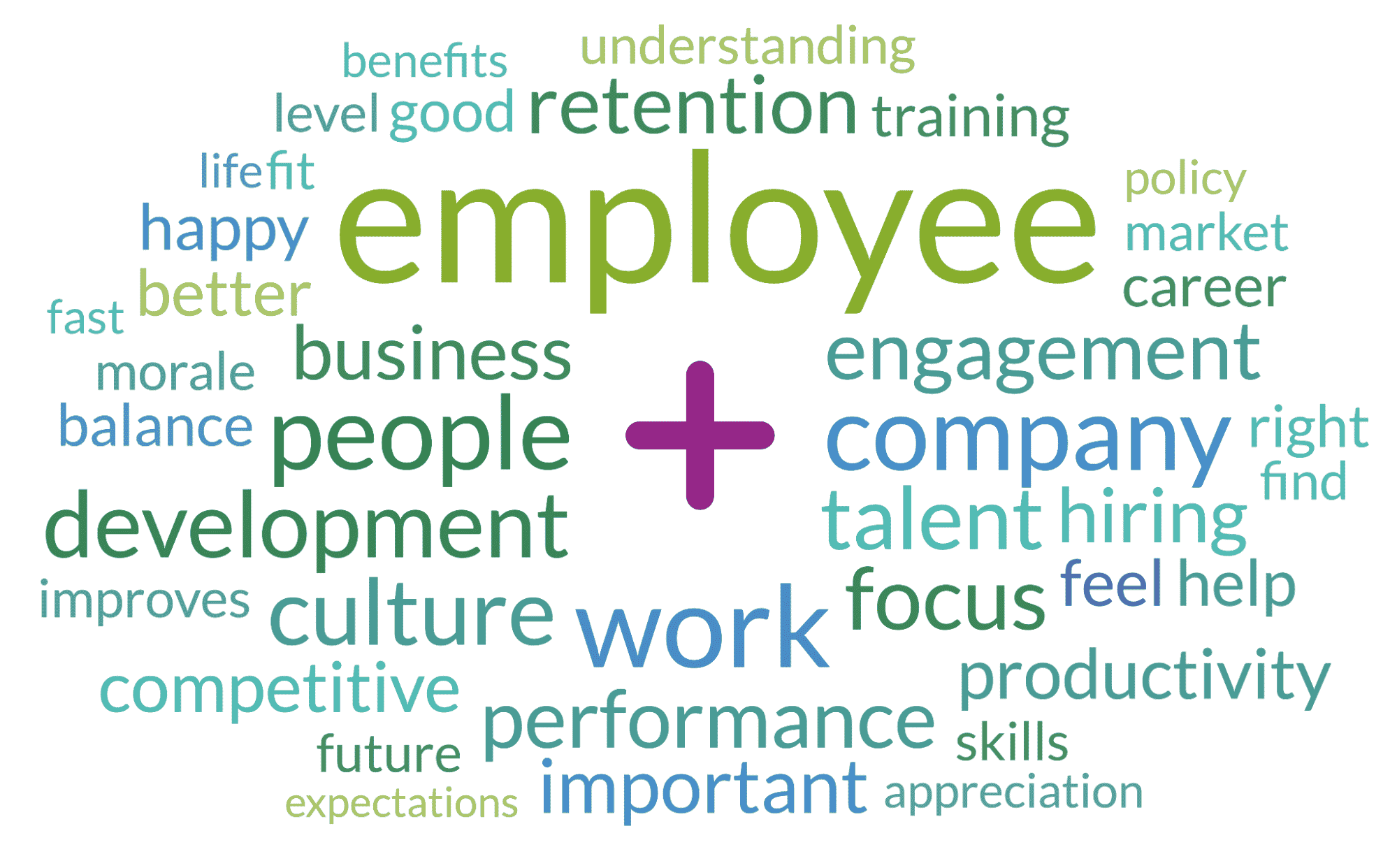
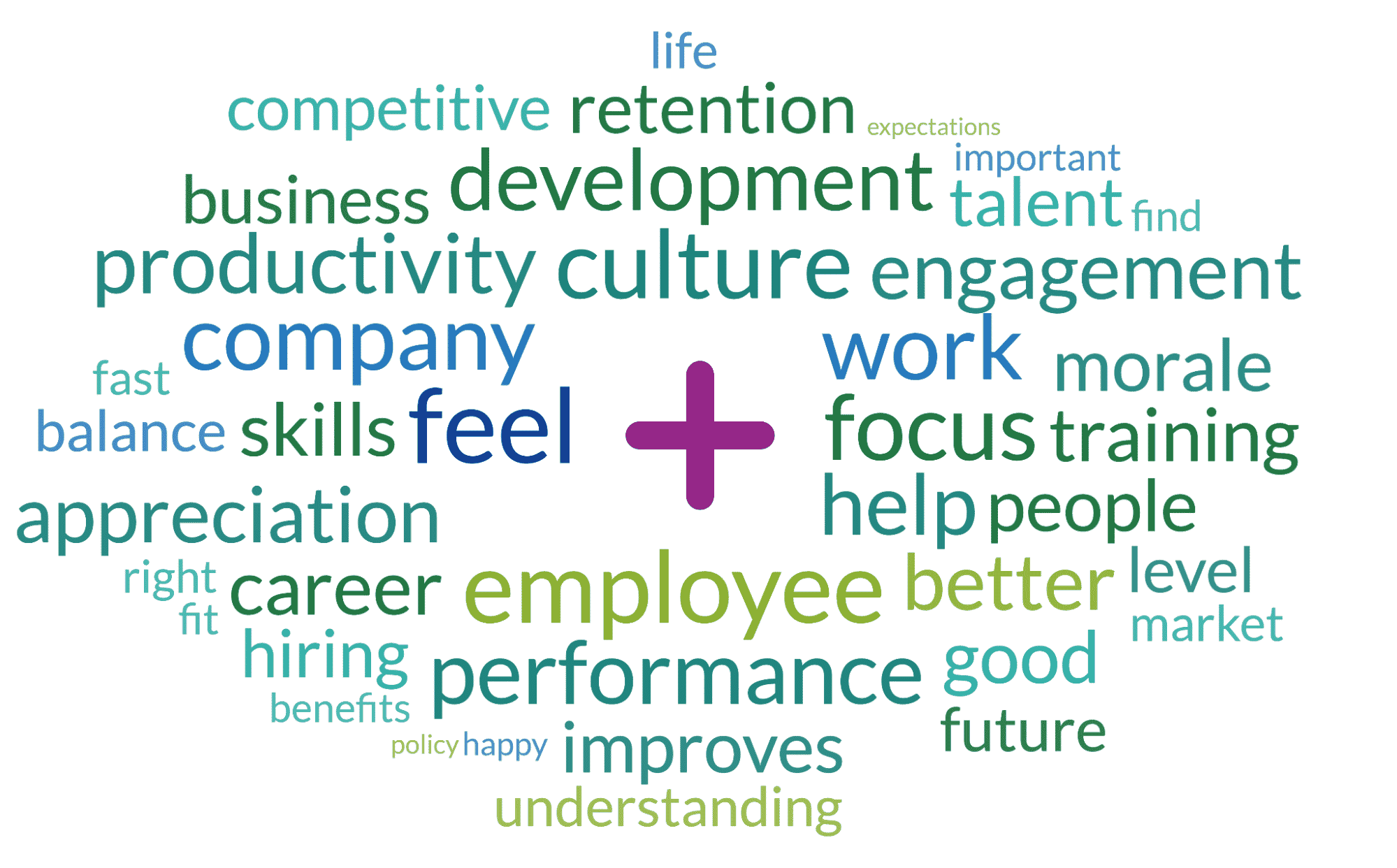
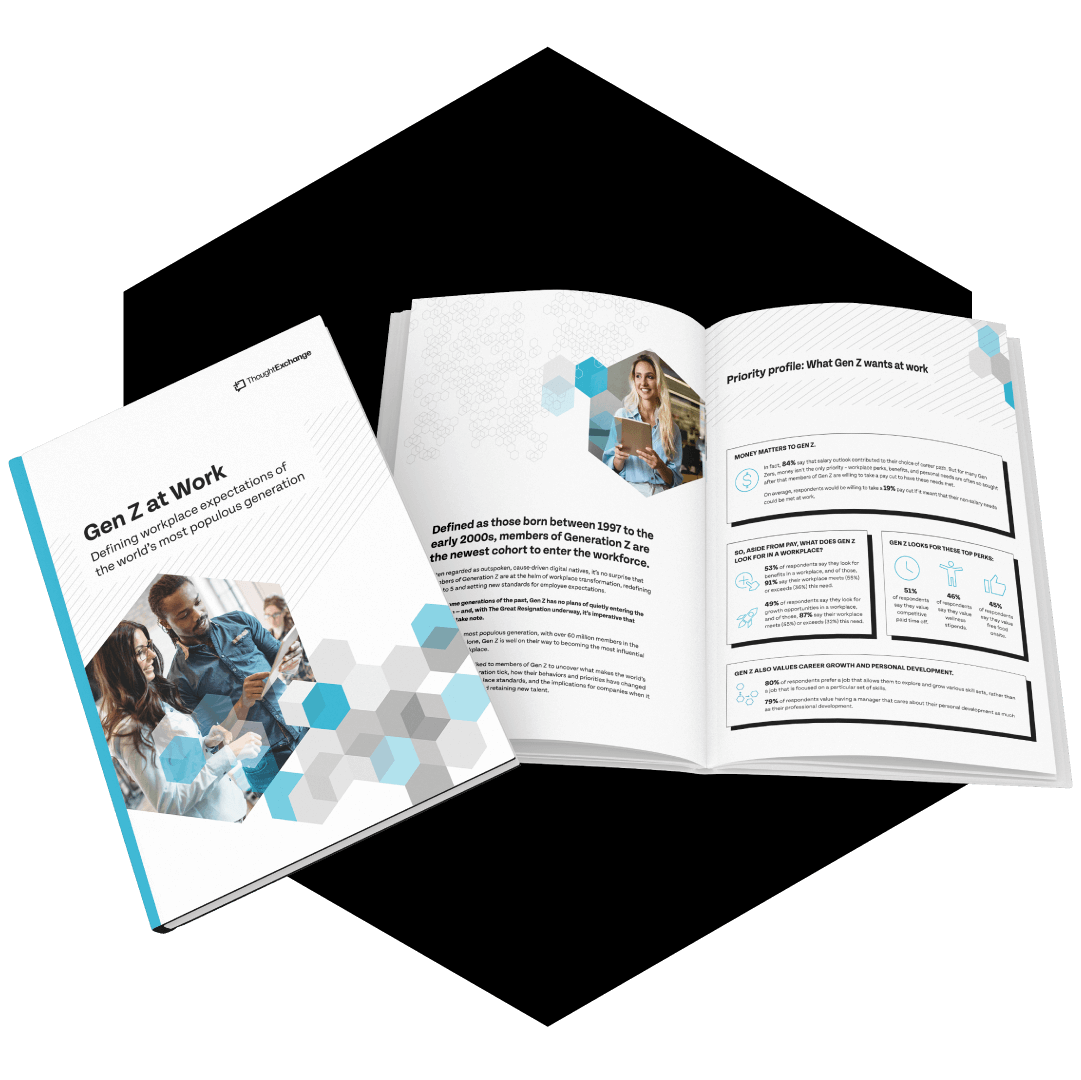
Ideas that rise to the top
Talent Acquisition:
The top five thoughts for Talent Acquisition express the importance of leadership development, employee engagement, competitive benefits, and a focus on wellbeing.
Recruitment:
Training & Development:
Diversity, Equity & Inclusion:
HR Leadership:
That last thought was initially in French—imagine if the group had missed out on one of the top-rated thoughts because participation was limited to English speakers!
These top thoughts are an indicator of how ThoughtExchange’s software innovates organizational communication. Each role has its individual priorities, and leaders have to balance the interests of individual teams with priorities for the organization as whole.
With our patented anti-bias technology and advanced analytics, ThoughtExchange quickly surfaces the common ground. The software identifies the thoughts that resonate across roles, so leaders can build a stronger foundation for decision-making.
Where participants disagreed
Of course, it’s not all common ground. ThoughtExchange’s Differences tool shows the rating patterns for different groups, and finds the polarizing ideas.
For example, in TalentCulture’s Exchange, compensation and pay equity was an area of contention. Group A (in blue), mainly HR Leadership, assigned high ratings (in the 4★ range) to these thoughts:
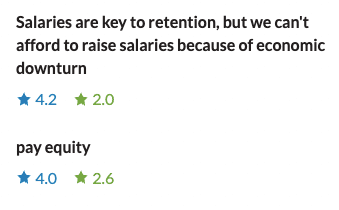
Group B (in green), consisting mainly of Recruitment, Training & Development, and Talent Acquisition folks, gave ratings averaging 2★. This may indicate a difference in priorities between HR Leadership and those responsible for hiring and upskilling employees.
The Differences tool doesn’t stop there. It also finds thoughts that Group A and Group B both rated highly. Both groups agreed that employee wellbeing and engagement are top priorities. Holding space for both sides of an issue is vital, but identifying where those two sides agree helps build a strategy everyone supports.
Areas of focus
The Theme tool helps identify the discussion’s general topics and themes. ThoughtExchange’s AI automatically creates Keyword themes, which group thoughts by keyword, and Sentiment themes, which group thoughts by positive, neutral, and negative sentiment. The Discover Dashboard also allows Exchange leaders to create their own manual Themes, structuring their results in a way that makes sense for their unique organization.
For TalentCulture’s Exchange, thoughts were manually categorized into three main themes: Culture, Performance, and Strategy. Under each of those summary themes, subthemes broke down the conversation further.
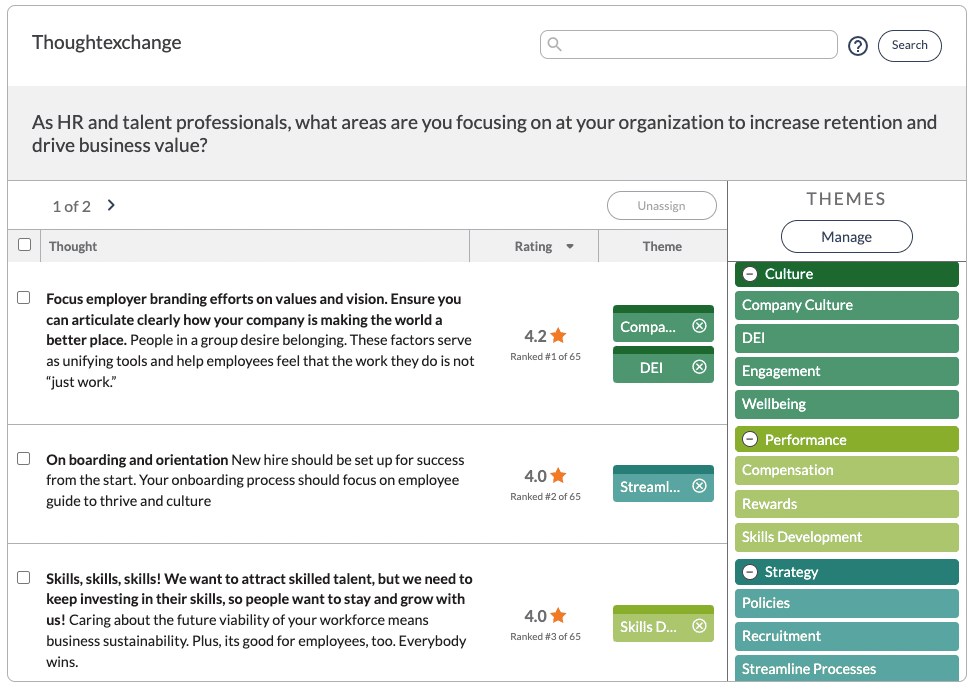
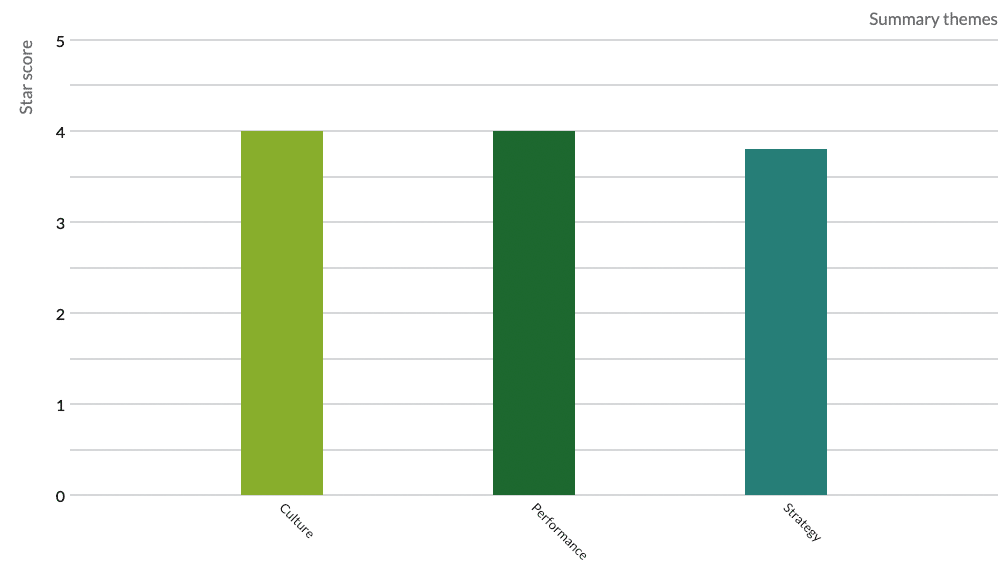
- Company Culture: employer branding, organizational culture, and employee experience
- DEI: inclusion, belonging, and equity in the workplace
- Engagement: employee listening, employee voice, engagement strategies
- Wellbeing: work/life balance, encouraging mental/emotional/social health, avoiding burnout
- Performance Appreciation: performance appreciation and rewards
- Skills Development: learning & development, leadership development, upskilling workforce, career development
- Compensation: benefits, competitive compensation, pay equity
- Recruitment: competitive recruitment processes, competitive offerings, internal talent development
- Streamline Processes: efficient onboarding/recruitment/hiring processes
- Policies: HR policies, employee expectations
Average ratings for the themes supported the previous observation about Wordcloud. As a theme, Policies had the lowest average rating at 3.2 stars—no other theme dipped below 3.9 stars. HR professionals are clearly more focused on fostering strong cultures and exceptional employee experience than they are on meticulous policies.
Clarity into the conversation’s focus areas shows which issues are the most pressing for the Talent and HR professional community. Analysis into each theme identified actions that could be the most effective in improving retention and driving business value.
- Company Culture: clarify organizational values to define employer brand, and consult employees on improving their experience at work.
- Skills Development: provide internal talent with career and leadership development opportunities, and upskill your workforce.
- Performance Appreciation: improve morale and productivity by rewarding high-performing employees.
Different roles & priorities, same goals
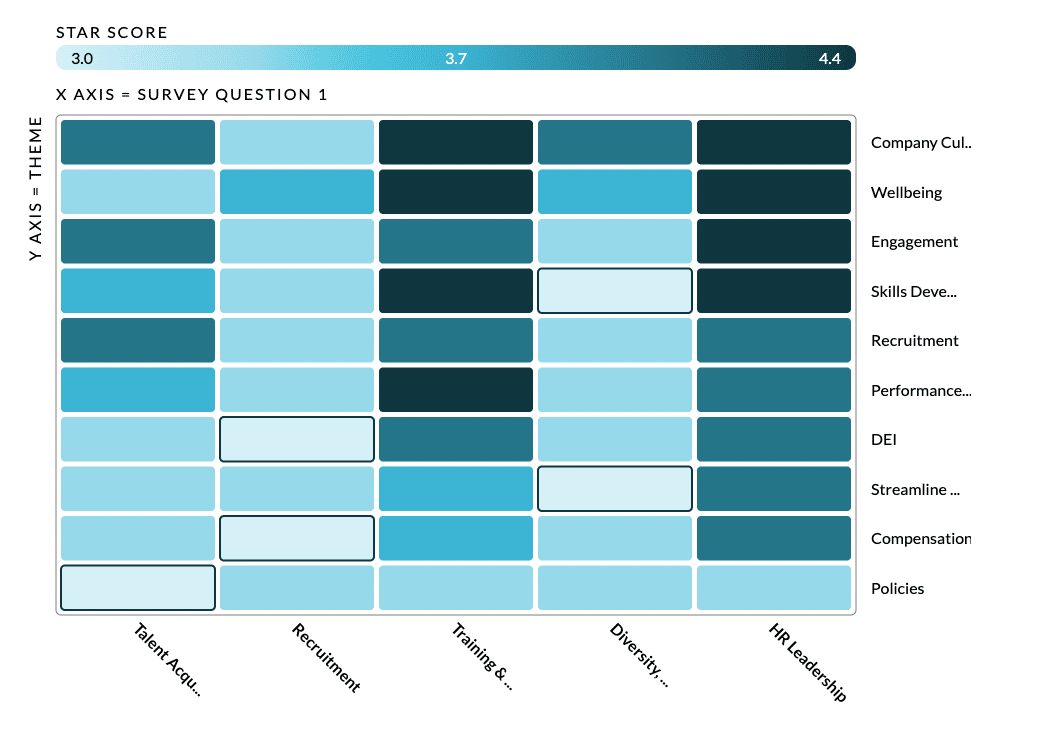
As for where the different roles agree, Company Culture and Wellbeing were assigned high ratings across roles. Talent Acquisition, Training & Development, and HR Leadership gave high ratings to the thoughts in Engagement and Recruitment.
It’s also interesting to note how each role rated thoughts. HR Leadership and Training & Development assigned higher ratings to thoughts overall than Talent Acquisition, Recruitment, and DEI.
Looking at how each role interacted with each others’ thoughts gives insight into where particular groups want to see focus and growth within their organizations. It can indicate where the stakeholders for each of these areas lie, as well as how each of these areas impacts their particular success metrics. For an organization that’s looking to improve efficiency, these are valuable insights into which teams to involve in which areas.
The interactions between roles can also help leadership allocate resources and attention to certain areas. For example, the Diversity, Equity & Inclusion team may benefit from information around how Skills Development, a lower-rated theme, can be particularly beneficial to underrepresented groups when seeking promotions, helping to meet their DEI goals.
Summarizing the results
Participants in this Exchange demonstrated they are invested in improving and streamlining every stage of the employee lifecycle. They value employee input on organizational culture and recognize the importance of robust onboarding and career development for internal talent. Above all, they care deeply for the wellbeing of employees, and are looking to find ways to foster a healthier work-life balance and a more inclusive and supportive workplace.
Thank you to those who participated in this insightful conversation. At a time when we’ve come to expect division and conflict, it’s crucial to offer spaces like this that foster respect and empathy for each other’s honest thoughts, allowing people to share diverse opinions while truly listening to and considering each other’s thoughts.




